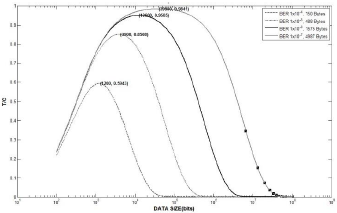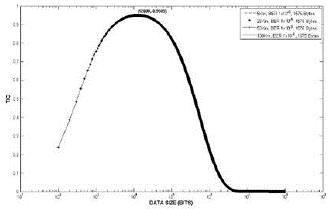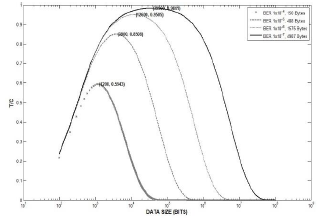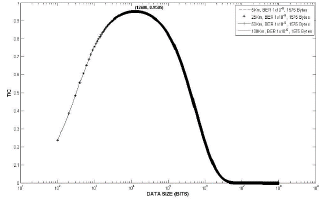1. Introduction
In data networks, it is notable that speed is affected significantly when the network supports applications that imply real-time data transmission, like music on demand (MOD), video on demand (VOD), voice IP services (VoIP), videoconference, etc., [1]. This degradation is given precisely because of the amount of information handled in these types of applications and by the data fragmentation process required in these types of apps. Due to this degradation of speed over the network [2] [3], in recent years considerable improvement has been made in the performance of data transmission over the physical links to improve the quality of service (QoS) [1] conditions on these applications, mainly because of the new skills required in the new data structure [4] [5], making it necessary to analyze some types of performance improvements. It is worth noting that until now, according to the research conducted, few studies have been made on the implementation of techniques that permit increasing the maximum transfer unit (MTU) [6].
This document implies the possibility of increasing the MTU in networks with next-generation Wi-Fi 802.11n-type link, without making modifications at software level within the devices that make up the network, but conducting an analysis of the physical parameters, like the bit error rate (BER) [7], and, thus, study the possibility of how to improve a network’s performance by increasing the MTU [8].
2. Materials and Methods
Environment. Wireless devices sharing the same protocol on the MAC header follow the IEEE 802.11 standard [9], of wireless local area network (WLAN); these devices are governed by different standards for the physical layer. For example, 802.11a, 802.11b, 802.11g, 802.11n, etc., all these standards support multirate transmissions [11]. Current research is significant to improve the performance of these networks, basically due to factors, like [12], multimedia applications, applications which are now more sensitive to the quality of service and to the inherent and internal deficiencies of wireless communications, such as scarce broadband resources and time variables of the channel conditions [13].
1) 802.11n standard. We will base our work on the 802.11n standard, given that it is a recommendation that tests and certifies that the equipment comply with the 802.11 standards related to WLAN, thus, thereafter an analysis was made of the type of control made and the components of the MAC header.
In the first place, the MAC header contains the following components: frame control, duration, address and sequence control information, and, for QoS of data frames, QoS of control information. In the second place, a variable longitude (frame body), which includes specific information for the type of frame and the subtype and, finally, FCS. The MAC header format includes a set of fields produced in a fixed order and all the frames.
Figure 1 represents the general format of the MAC frame. The first three fields of the control frame, Frame Control, Duration/ID, and Address 1, and the last field (FCS) constitute the minimum frame format and are present in all the frames, including the types and subtypes reserved. The Address of fields 2, 3, Sequence control, Address 4, QoS Control, HT control, and frame body are present only in certain types of frames and subtypes. The bodily structure field is of variable size.
The maximum size of the frame body is determined by the maximum size MSDU (2304 octets) plus any security encapsulation overload, Table 1[14].
Table 1 MAC frame format [10].
| Octets | ||||||||||
| 2 | 2 | 6 | 6 | 6 | 2 | 6 | 2 | 4 | 0 - 9955 | 4 |
| Frame Control | Duration/ID | Address 1 | Address 2 | Address 3 | Sequence Control | Address 4 | QoS Control | HT Control | Frame Body | FCS |
| MAC Header | ||||||||||
The first field of the MAC header is the frame control, which consists of the following subfields, Table 2, Protocol Version, Type, Subtype, To DS, From DS, More Fragments, Retry, Power Management, More Data, Protected Frame, and Order.
Table 2 Header, Control frame [13].
| B0 - B1 | B2 - B3 | B4 - B7 | B8 | B9 | B10 | B11 | B12 | B13 | B14 | B15 |
| Protocol version | Type | Subtype | To DS | From DS | More Frag | Retry | Pwr. Mgt. | More Data | Protected Frame | Order |
| Bits | ||||||||||
| 2 | 2 | 4 | 1 | 1 | 1 | 1 | 1 | 1 | 1 | 1 |
The header function (Table 2) is that of identifying fields by type and subtype, where the type field is 2 bits long and the subtype field is 4 bits long. Three types of frames are available: control, data, and management.
In the data frames, the most significant bit (MSB) of subtype is b7, and is defined as QoS subfield, considered of importance because this subfield describes the quality of service, which allows us to know the situation of the data frame, for example, Table No. 3 describes how it functions around this field [15]. Change of the value type bits will depend on what has to be done, whether we receive an ack (acknowledgment) or a nack (no acknowledgment); likewise, for the value of the subtype. The field of QoS control is present in all data frames, so this field is established in 1 (assume the value of 1), this information allows knowing the field description.
Table 3 Valid type and combinations of subtype.
| Type value b3 b2 | Type Description | Subtype value b7 b6 b5 b4 | Subtype Description |
|---|---|---|---|
| 01 | Control | 1101 | ACK |
| 00 | Management | 1110 | NOT-ACK |
2.1 Statistical analysis
The probability of getting a frame error in the receptor is P, so the probability of getting a correct reception is (1-P). The field length in the packet frame is Ld. The length of the packet frame control system is Lc. The probability of bit error, BER, refers to the amount of errors that can be found statistically in a channel [3]. Basically, due to the very characteristics of the channels, like the signal-to-noise ratio (SNR). Assuming the BER, as the probability of bit error, that is, that at least one bit shows error within the frame, then the probability of no error in the frame is the probability of the BER elevated to the total size of the frame, and it is calculated according to the following equation
Based on Table 1, and aware that the size of the control field is 320 bits, it is taken on a fixed value, while the size of the data changes. To conduct the simulation of the channel efficiency, it is important to bear in mind the following variables [11]: Transmission Capacity is C; time of propagation, Tp, which depends on the velocity of propagation, Vp, where Vp = Vc/Er, speed of light and relative permittivity of air and distance X, thus, Tp = X/Vp, the time required to transmit a frame Ti, Ti = (Ld + Lc )/C; time out, Tout; total time, Tt, which is equal to Tt = Ti + Tout, a is a standardized parameter that represents the time out in an equal intervala = Tt /Ti, applying the following equation:
3. Results
For the simulations, we used MATLAB. In the first place, the link will be simulated with the parameters listed in Table 4. Transmission capacity will vary, while distance remains constant. Each line in Figure1 represents a different value of BER.
Table 4 Simulation parameters.
| Channel | Velocity | Distance | B. E. R. |
| 1.C | 150 Mbps | 1km | 1e-4, 1e-5, 1e-6, 1e-7 |
| 2. C | 300 Mbps | 1km | 1e-4, 1e-5, 1e-6, 1e-7 |
| 3. C | 600 Mbps | 1km | 1e-4, 1e-5, 1e-6, 1e-7 |
Figure 1 is a summary of the three situations evaluated because they always behaved similarly, yielding the same values in the x axis corresponding to bits; these values were divided over eight to obtain the value in Bytes and compare to the values currently available for wireless transmissions, as evidenced in Figure 2[7]. In addition, the simulation of the link will be conducted with the parameters in Table 5. Thus, distance will vary, while capacity remains constant; each line on the graphic represents a different value of BER.
Table 5 Simulation parameters for varying distances.
| Channel | Velocity | Distance | B. E. R |
| 1. C | 300 Mbps | 5 km | 1e-4, 1e-5, 1e-6, 1e-7 |
| 2. C | 300 Mbps | 25 km | 1e-4, 1e-5, 1e-6, 1e-7 |
| 3. C | 300 Mbps | 50 km | 1e-4, 1e-5, 1e-6, 1e-7 |
| 4. C | 300 Mbps | 100 km | 1e-4, 1e-5, 1e-6, 1e-7 |
Figure 3 shows that as with the previous case, the change occurs in the data (bits). If the capacity is the same, but transmission distance varies, the final results demonstrate that the values in the throughput capacity (T/C) ratio are the same, the only thing that varies is the propagation time due to changes in distance.
As noted above, the capacity and distance variables do not alter the results in any way, upon evaluating the situation of the constant channel and variable distance, we obtained the results shown ahead, reaffirming no dependence on distance (Table 6).
Table 6 Results of the simulation with constant capacity.
| Capacity | Distance | Ber |
|---|---|---|
| 300 Mbps | 5 km | 1e-6 |
| 300 Mbps | 25 km | 1e-6 |
| 300 Mbps | 50 km | 1e-6 |
| 300 Mbps | 100 km | 1e-6 |
4. Conclusions
The results show that the channel capacity is not a variable that somehow determines the maximum bit value in the transmission, given that the time to place the frame in the channel depends on the header size, (data and control) and on the throughput capacity (Ti = (Lc + Ld )/C). Indicating that Ti will always tend to zero.
When having the same BER value and the same capacity, in spite of varying the distance, the values of the T/C ratio are the same for all distances, evidencing that the BER is the most important parameter in the T/C ratio.
The simulation where the MATLAB tool was not used permits determining parameters and their changes, without need to intervene directly on the frame or its components, speeding up changes and improvements in communication systems.




















